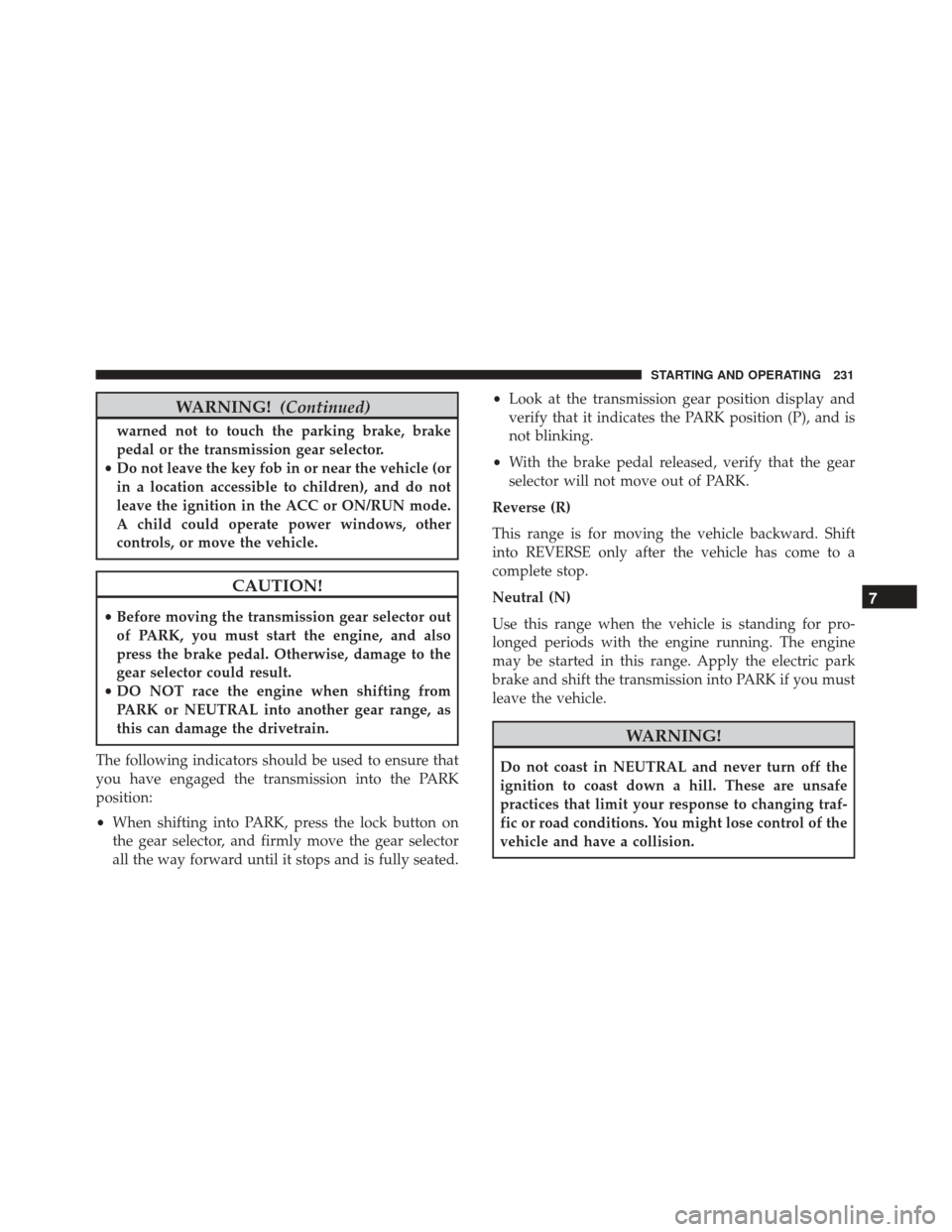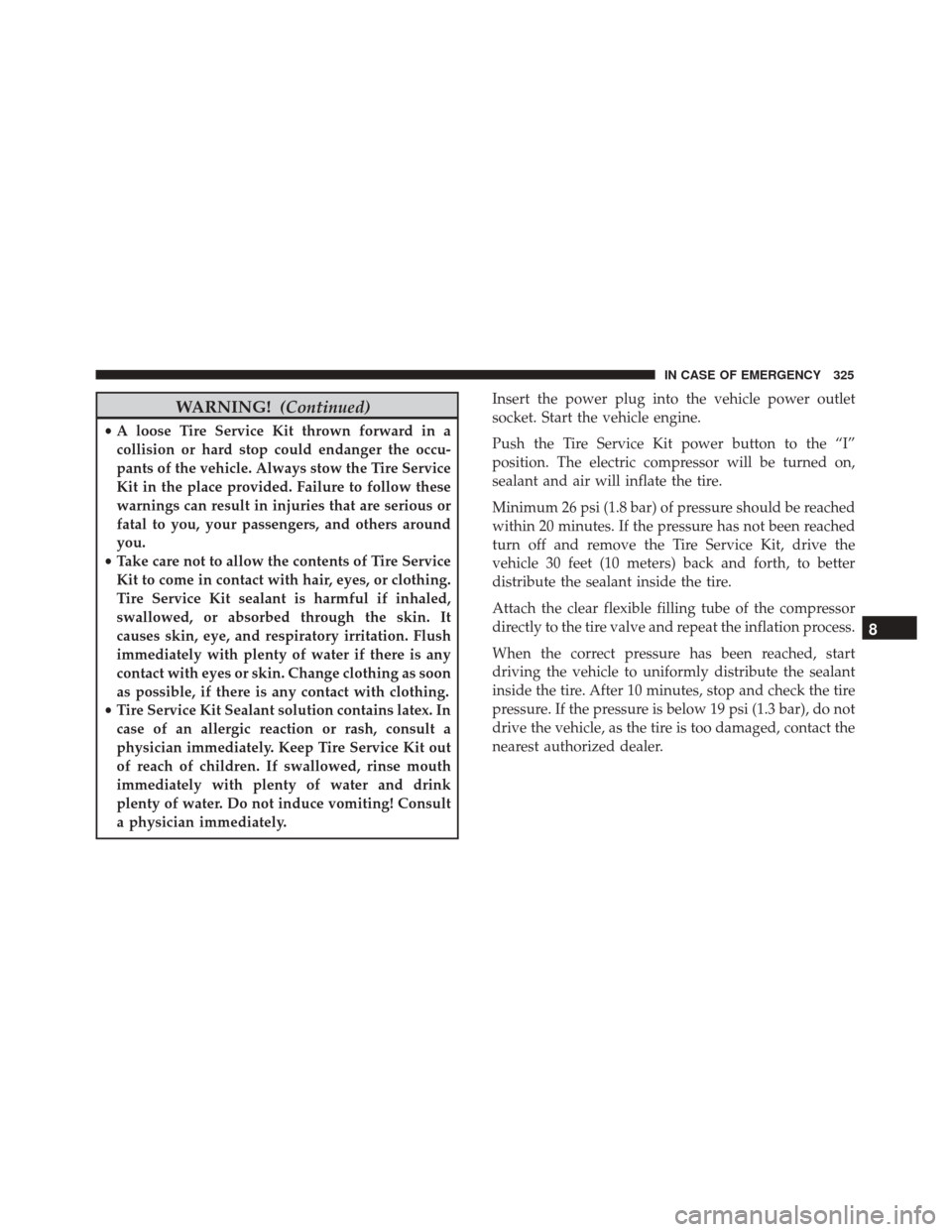Page 233 of 476

WARNING!(Continued)
warned not to touch the parking brake, brake
pedal or the transmission gear selector.
• Do not leave the key fob in or near the vehicle (or
in a location accessible to children), and do not
leave the ignition in the ACC or ON/RUN mode.
A child could operate power windows, other
controls, or move the vehicle.
CAUTION!
• Before moving the transmission gear selector out
of PARK, you must start the engine, and also
press the brake pedal. Otherwise, damage to the
gear selector could result.
• DO NOT race the engine when shifting from
PARK or NEUTRAL into another gear range, as
this can damage the drivetrain.
The following indicators should be used to ensure that
you have engaged the transmission into the PARK
position:
• When shifting into PARK, press the lock button on
the gear selector, and firmly move the gear selector
all the way forward until it stops and is fully seated. •
Look at the transmission gear position display and
verify that it indicates the PARK position (P), and is
not blinking.
• With the brake pedal released, verify that the gear
selector will not move out of PARK.
Reverse (R)
This range is for moving the vehicle backward. Shift
into REVERSE only after the vehicle has come to a
complete stop.
Neutral (N)
Use this range when the vehicle is standing for pro-
longed periods with the engine running. The engine
may be started in this range. Apply the electric park
brake and shift the transmission into PARK if you must
leave the vehicle.
WARNING!
Do not coast in NEUTRAL and never turn off the
ignition to coast down a hill. These are unsafe
practices that limit your response to changing traf-
fic or road conditions. You might lose control of the
vehicle and have a collision.
7
STARTING AND OPERATING 231
Page 237 of 476

Ignition Park Interlock
Vehicles Equipped With Keyless Enter-N-Go:
This vehicle is equipped with an Ignition Park Inter-
lock, which requires the transmission to be in PARK
before the ignition can be turned to the STOP/OFF
mode. Also, the transmission is locked in PARK when-
ever the ignition is in the STOP/OFF mode.
Brake/Transmission Shift Interlock System
This vehicle is equipped with a Brake Transmission
Shift Interlock system (BTSI) that holds the transmis-
sion gear selector in PARK unless the brakes are ap-
plied. To shift the transmission out of PARK, the igni-
tion must be cycled to the RUN mode (engine running
or not) and the brake pedal must be pressed.
The brake pedal must also be pressed before pushing
the button on the gear selector to shift from NEUTRAL
into DRIVE or REVERSE when the vehicle is stopped or
moving at low speeds.
SPEED CONTROL — IF EQUIPPED
When engaged, the Speed Control takes over accelera-
tor operations at speeds greater than 25 mph (40 km/h).The Speed Control buttons are located on the right side
of the steering wheel.
NOTE:
In order to ensure proper operation, the Speed
Control System has been designed to shut down if
multiple Speed Control functions are operated at the
same time. If this occurs, the Speed Control System can
be reactivated by pushing the Speed Control on/off
button and resetting the desired vehicle set speed.
Speed Control Buttons
1 — On/Off 4 — SET-/Decel
2 — SET+/Accel 5 — CANC/Cancel
3 — RES/Resume
7
STARTING AND OPERATING 235
Page 238 of 476

Activation
Push the on/off button to activate the Speed Control.
The cruise indicator light in the instrument cluster
display will illuminate. To turn the system off, push the
on/off button a second time. The cruise indicator light
will turn off. The system should be turned off when not
in use.
WARNING!
Leaving the Speed Control system on when not in
use is dangerous. You could accidentally set the
system or cause it to go faster than you want. You
could lose control and have an accident. Always
leave the system off when you are not using it.
Setting A Desired Speed
Turn the Speed Control on.
NOTE:The vehicle should be traveling at a steady
speed and on level ground before pushing the SET (+)
or SET (-) button. When the vehicle has reached the desired speed, push
the SET (+) or SET (-) button and release. Release the
accelerator and the vehicle will operate at the selected
speed.
Deactivation
A soft tap on the brake pedal, pushing the CANC
button, ESC intervention, brake control mitigation, elec-
tronic park brake intervention, or normal brake pres-
sure while slowing the vehicle will deactivate the Speed
Control without erasing the set speed from memory.
Pushing the on/off button or turning the ignition
switch to STOP erases the set speed from memory.
Resume Speed
To resume a previously set speed, push the RES button
and release. Resume can be used at any speed above
20 mph (32 km/h).
Varying The Speed
To Increase Speed
When the Speed Control is set, you can increase speed
by pushing the SET
(+)button.
236 STARTING AND OPERATING
Page 327 of 476

WARNING!(Continued)
•A loose Tire Service Kit thrown forward in a
collision or hard stop could endanger the occu-
pants of the vehicle. Always stow the Tire Service
Kit in the place provided. Failure to follow these
warnings can result in injuries that are serious or
fatal to you, your passengers, and others around
you.
• Take care not to allow the contents of Tire Service
Kit to come in contact with hair, eyes, or clothing.
Tire Service Kit sealant is harmful if inhaled,
swallowed, or absorbed through the skin. It
causes skin, eye, and respiratory irritation. Flush
immediately with plenty of water if there is any
contact with eyes or skin. Change clothing as soon
as possible, if there is any contact with clothing.
• Tire Service Kit Sealant solution contains latex. In
case of an allergic reaction or rash, consult a
physician immediately. Keep Tire Service Kit out
of reach of children. If swallowed, rinse mouth
immediately with plenty of water and drink
plenty of water. Do not induce vomiting! Consult
a physician immediately. Insert the power plug into the vehicle power outlet
socket. Start the vehicle engine.
Push the Tire Service Kit power button to the “I”
position. The electric compressor will be turned on,
sealant and air will inflate the tire.
Minimum 26 psi (1.8 bar) of pressure should be reached
within 20 minutes. If the pressure has not been reached
turn off and remove the Tire Service Kit, drive the
vehicle 30 feet (10 meters) back and forth, to better
distribute the sealant inside the tire.
Attach the clear flexible filling tube of the compressor
directly to the tire valve and repeat the inflation process.
When the correct pressure has been reached, start
driving the vehicle to uniformly distribute the sealant
inside the tire. After 10 minutes, stop and check the tire
pressure. If the pressure is below 19 psi (1.3 bar), do not
drive the vehicle, as the tire is too damaged, contact the
nearest authorized dealer.
8
IN CASE OF EMERGENCY 325